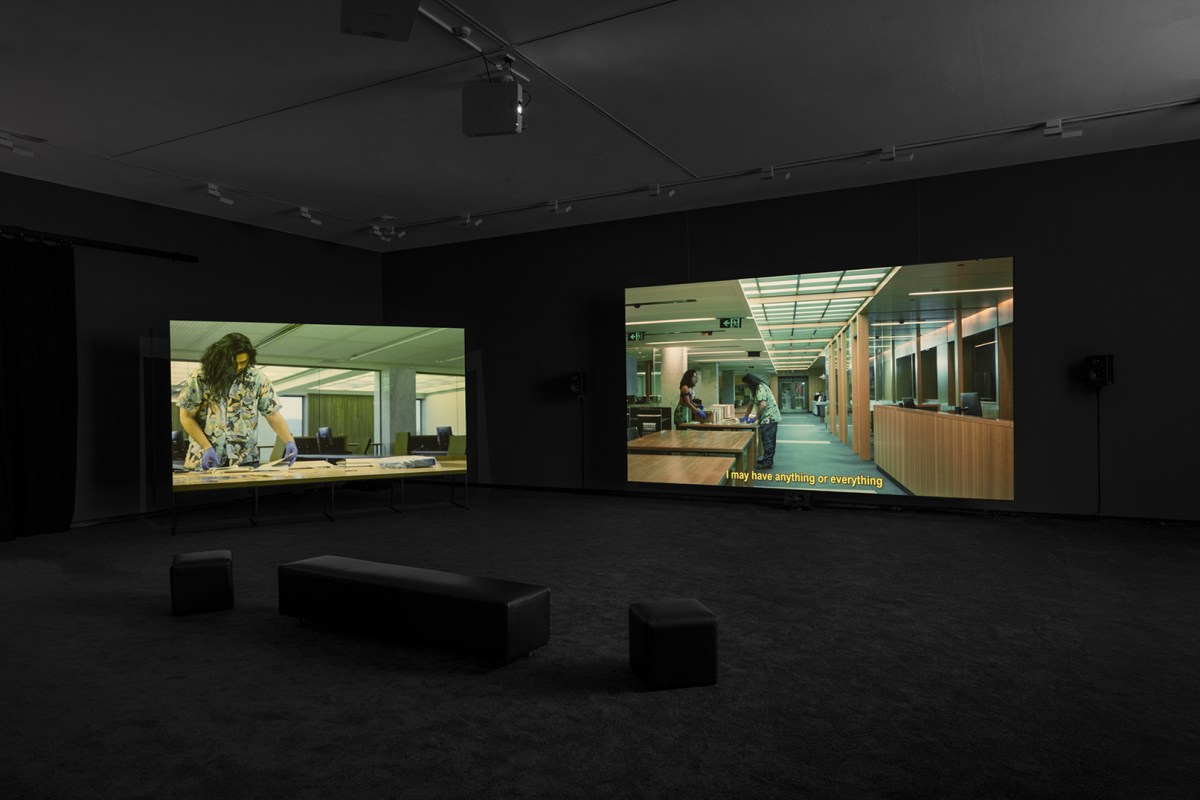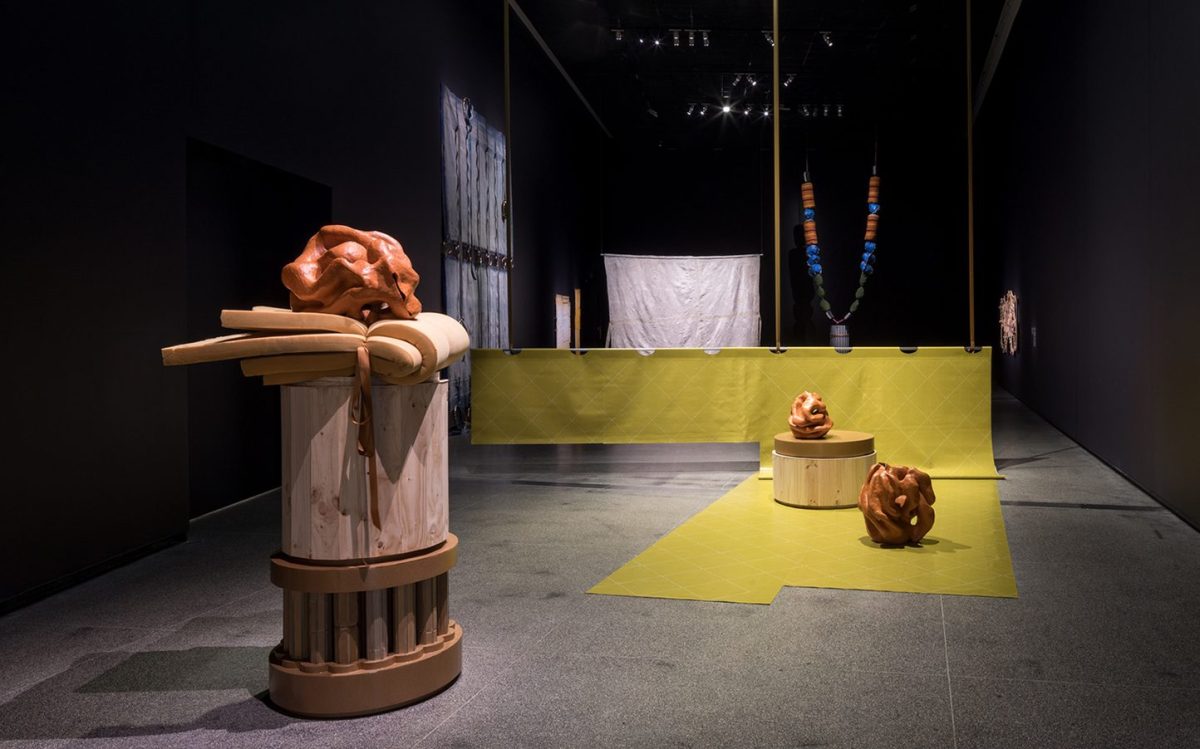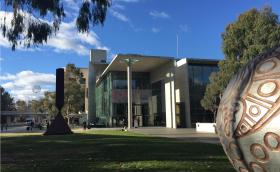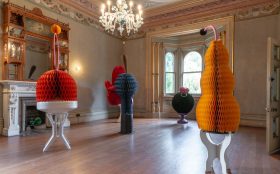The Australian Centre for Contemporary Art (ACCA) is once again presenting the Macfarlane Commissions, supporting new commissions of scale by emerging and mid-career artists.
As compared to the previous 2022 iteration that ‘upend[ed] painting’s stereotypes’, this year’s showcase, Future Remains, sees artists heavily engaged in material investigations, through which they navigate, reflect upon and seek to change the course of contemporary dialogue.
Nicholas Smith’s a gentle hesitation between (2024) forms an alluring entrance to the exhibition. Tactile sculptures with a walnut-like form and surface resembling leather are in fact constructed from terracotta. Displayed on plinths constructed from found material, the work sees Smith juxtapose the so-called “highbrow” and “lowbrow” in this poetic installation. It is densely packed with the artist’s exploration of queer sexuality, class, craftsmanship and memory, along with his interest in histories of décor. Similar motifs featured in a collaborative exhibition with Jeremy Eaton at Incinerator Gallery that closed in June. At ACCA, however, they are much more detailed and drawn out.
These pieces resonate strongly with Teelah George’s works nearby, where labour is palpable in the form of hand-embroidered stitches and arduously cast bronze embellishments. Perpetual horizon (2024), a tattered five- by four-metre truck vinyl (tautliner) with bronze circles that call to mind gymnastics rings, and Wall piece (2024) sag against their own weight like tired workers. Together with the bronze and Blu-Tack embellished cardboard pieces Tablet with blue and Tablet with orange (both 2024), they are given a second life in the gallery with memory of the first clinging on.
For the Macfarlane Commissions, Salote Tawale is presenting an installation of monumental scale, titled Constellation 1976 (2024). The work is accompanied by Noica Omero’s sound design and appears like a beaded necklace made out of textiles and metal significant to Tawale. The artist, with Indigenous Fijian and Anglo-Australian heritage, has a rather mature practice and has always been comfortable working in a large format, with a 2023 major solo at Carriageworks and curated into a handful of exhibitions in the past two years across Australia and Aotearoa New Zealand. Constellation 1976 is not spectacular per se, but its presence is grounding, displaying the confidence of a mid-career artist. (Tawale received the Create NSW Visual Arts Mid-Career/Established Fellowship in 2017.)
Also in the first gallery space is Kim Ah Sam’s woven wall piece, also described as ‘a constellation or a map’. It’s of modest size among the giants, but makes up for it in its intricate detail rich in tradition and storytelling.
These four artists hold up against the vast gallery space of ACCA, and nothing gets swallowed or overpowered, which is no mean feat in itself.
A really strong piece in the Macfarlane Commissions this year is Andy Butler’s three-channel video, Living Truthfully in Invented Circumstances (2024). Drawing upon history, research, film culture, archival practices and lived experiences to re-enact the absurdity of racial stereotypes around Southeast Asia, the work is powerfully articulate and humorously subversive. The floor-to-ceiling screens and zoomed in shots physically enlarge the presence of the Asian Australian cast, ensuring viewers are compelled to acknowledge the towering figures in whatever activity or performance they are undertaking.

Moving on from here, Alexandra Peters’ installation replicating the energy of corporate offices and Joel Sherwood Spring’s pseudo infomercial marketing an Indigenous Utopia feel quite disparate from the rest of Future Remains.
Peters also embarks on a level of material investigation in Breakneck (2024), with multilayered abstract paintings that have undergone complicated processing to mark, wipe out and remark their surfaces. Perhaps intentionally difficult to discern, the work may require viewers to do a double take on the exhibition didactic to fully grasp its conceptual underpinning. Meanwhile, the intention of Spring’s SETTLED (2024) is clear, but it lacks a more enticing hook to sustain attention in an otherwise bland set-up.
The 2024 iteration of the Macfarlane Commissions has prompted this reviewer to consider the categorisation of “emerging” and “mid-career”, which has always been more or less ambiguous. How useful are these definitions, if not for the sake of convenience around commercial value, and what nuances are lost by grouping them together under one umbrella? The birth years in Future Remains span 1967 (Ah Sam) to 1992 (Spring) with two and a half decades in between.
While “early-career” is thankfully no longer tied to age or graduate status, it’s generally a convention in the arts that no one gets the “mid-career” title before the age of 40 or 45 and some bind mid-career to a professional practice of at least 10 years. Of course, this is not to say exhibitions can only show artists of similar career stages, but for the commissioning opportunity to consider the fact that the required level of support, or the form that it takes (monetary, curatorial, conceptual etc), is different. These factors directly influence the impact of such commissions, as well as the exhibition experience.
Read: Exhibition review: Emerging Artist Award 2024, fortyfivedownstairs
Nonetheless, ACCA’s Macfarlane Commissions has established itself as an insightful indication of rising stars and the topical discussions relevant to contemporary practising artists, and a valued platform for engagement and reflection. With the series now extended beyond its original duration of 2022, it is hoped that it continues to grow and evolve to align with the needs of the artists it seeks to support.
Future Remains: The 2024 Macfarlane Commissions is on view at ACCA until 1 September; free.






